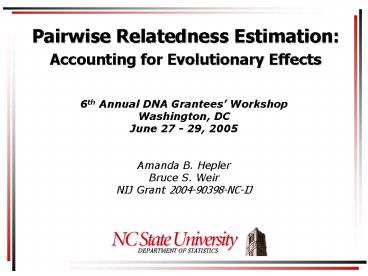Pairwise Relatedness Estimation: Accounting for Evolutionary Effects - PowerPoint PPT Presentation
1 / 13
Title:
Pairwise Relatedness Estimation: Accounting for Evolutionary Effects
Description:
Washington, DC. June 27 - 29, 2005. Amanda B. Hepler. Bruce S. ... This extra relatedness should be taken into account when estimating pairwise relatedness. ... – PowerPoint PPT presentation
Number of Views:74
Avg rating:3.0/5.0
Title: Pairwise Relatedness Estimation: Accounting for Evolutionary Effects
1
Pairwise Relatedness Estimation Accounting for
Evolutionary Effects
- 6th Annual DNA Grantees Workshop
- Washington, DC
- June 27 - 29, 2005
- Amanda B. Hepler
- Bruce S. Weir
- NIJ Grant 2004-90398-NC-IJ
2
Outline
- What is Pairwise Relatedness?
- Why is it Important?
- What are Evolutionary Effects?
- New Maximum Likelihood Estimator
- A Simulation Study
- FBI Data Analysis
3
What is Pairwise Relatedness (PR)?
- When considering two individuals, there exists an
amount of relatedness between them. - For example, if they are siblings they will have
a higher amount of relatedness than if they were
not siblings. - Inference about relatedness between two
individuals can be achieved by observing
similarities and differences between genotypes at
various loci. - Similarity in genetic makeup is an indicator of
relatedness.
4
Why is PR Important?
- Remains identification
- Cannot always rely on visual ID, dental records,
etc. - Courtroom
- Only relative available for DNA testing.
- Defense suggests a relative is the culprit of the
crime - Population genetics applications
5
Evolutionary Effects
- Evolutionary theory states that subpopulations
exist within most human populations. - People could tend to mate within their
subpopulation, resulting in inbreeding. - Inbreeding adds an additional amount of
relatedness between random individuals within a
subpopulation. - This extra relatedness should be taken into
account when estimating pairwise relatedness.
6
Measuring Pairwise Relatedness
- Coancestry coefficient (?XY) probability a
random allele from X is identical by descent to a
random allele from Y. - Common ?XY values
- Unrelated 0 (Min)
- Cousins 1/16
- Full sibs 1/4
- Identical Twins 1/2 (Max)
- Jacquards coefficients ? (?1, ?2, ?3, ?4, ?5,
?6, ?7, ?8, ?9) See handout for more details.
7
Maximum Likelihood
- Use maximum likelihood estimation.
- First we estimate Jacquards coefficients.
- Then we use the following relationshipto
obtain an estimate for ?XY. - If evolutionary effects are ignored ?1 ?6
0. - This estimator was first proposed by Thompson,
and is commonly used today. - E.A. Thompson. The Estimation of Pairwise
Relationships (1975). Annals of Human Genetics.
39 173-188.
8
Simulation Study
- Compare two estimators of pairwise relatedness
- MLE using only 3 parameters (?1 ?6 0),
- MLE using all 9 parameters (all ?i 0).
- Investigate the effects of varying the
- amount of inbreeding,
- number of loci,
- number of alleles per locus,
- and true relationship.
9
3 Parameter Model Means
Mean Relatedness Estimates vs. Number of Loci
Inbreeding Coefficient
True Relationship
10
9 Parameter Model Means
Mean Relatedness Estimates vs. Number of Loci
Inbreeding Coefficient
True Relationship
11
FBI Data
- Data obtained from http//www.fbi.gov/hq/lab/fsc/b
ackissu/july1999/budowle.htm - Individuals were typed at 20 markers,
- 3 28 alleles per locus.
B.S. Weir, W.G. Hill. Estimating F-Statistics
(2002). Annual Review of Genetics. 36 721-750.
12
FBI Data Results
- Randomly selected 500 unrelated pairs from each
group. - Mated those pairs to produce 500 full sibling
pairs.
13
Conclusions
- Need several loci for both estimators to perform
well. - More alleles is better, but not as important.
- Recommend using 9 parameter estimator for inbred
populations. - For non-inbred, existing methods are less biased.
- THANK YOU!!































